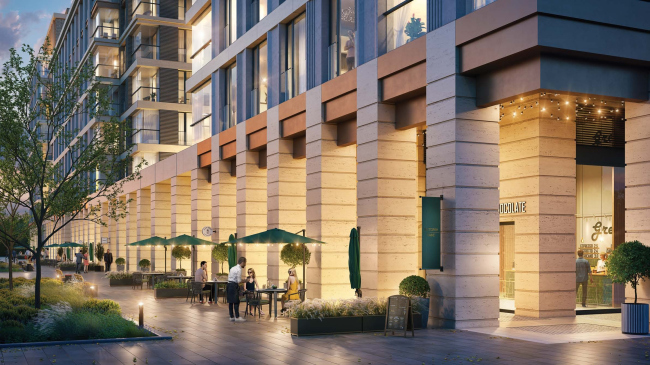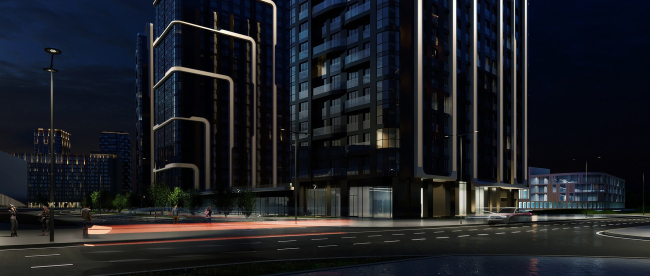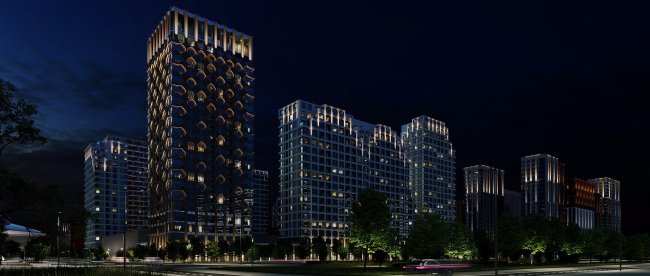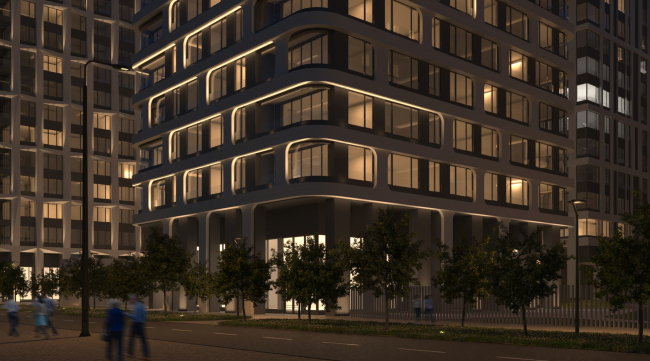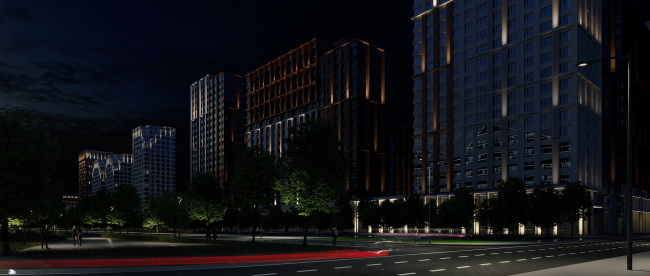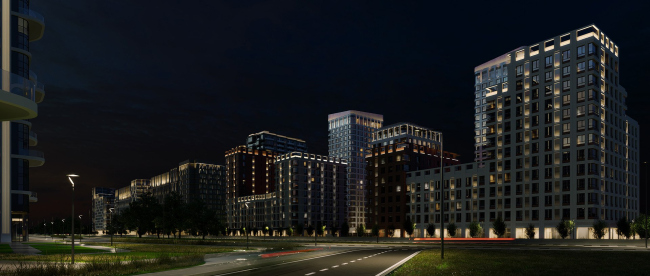|
Published on Archi.ru (https://archi.ru) |
|
| 17.07.2023 | |
|
The Light for the Island |
|
|
Julia Tarabarina |
|
| Architect: | |
| Yuliy Borisov | |
| Studio: | |
| UNK | |
|
For the first time around, we are examining a lighting project designed for a housing complex; but then again, the authors of the nighttime lighting of the Ostrov housing complex, UNK lighting, proudly admit that this project is not just the largest in their portfolio, but also the largest in this country. They describe their approach as a European one, its chief principles being smoothness of transitions, comfort to the eye, and the concentration of most of the light at the “bottom” level – meaning, it “works” first of all for pedestrians. Architectural illumination projects in the city are not a new thing – they have been around for decades – but over the last 10-12 years they have reached, as it seems, a whole new level. In any case, driving through Moscow in the evening, it is hard not to pay attention to the brightly lit tops of both Stalin-era houses and modernist “slabs”, which makes the city look different at night from the daytime. One way or another, the evening light has a serious effect on us: it calms us down, assuring the passerby’s feelings of the city’s safety, and it sets accents, creating some kind of its own agenda and dictating some kind of a “melody” of its own. "Ostrov« (»Island") housing complex. The concept of architectural lightingCopyright: © UNKThe task of the project was not only to unite the whole complex with an integrated lighting solution in the evenings, but also to create for the “new city” its own image, with its own subtleties and peculiarities, and a recognizable one, too. Alexandra Ushakova, UNK lighting This project is unique not only for us – after all, it consists of 10 full-fledged city blocks – but, I would say, for Moscow and Russia as well. In all the projects we work with, we strive to offer integrated solutions, to link different elements, landscape, public places, small architectural forms, and so on. We fine-tune energy efficiency. However, this project is the biggest and the most complex we’ve done so far. We started by working on references: we studied the works of the world’s leading lighting designers, for example, the lighting of the Wilkinson Air apartment complex in the gas holders at King’s Cross, or Smart City in Qatar, as it is, just like ours, a brand-new city, and there is a lighting design code there. We categorized the approaches into three types: American, Asian and European. In the U.S., a lot of attention is paid to advertising and illumination of the upper parts of high-rise buildings; Asian lighting is very bright, multicolor for the full range of RGB equipment, and dynamic. In Europe, maximum attention is paid to landscape and art objects, everything that is at human level, and buildings are illuminated only when they are true monuments of architecture. The UNK architects are inspired by the European approach, when the buildings are designed to be perceived from the pedestrian’s point of view; in addition, the predominance of lighting in the lower tier correlates well with the urban galleries conceived in the lower floors – the new residential areas should be pleasant to move around in, creating both a cozy and lively boulevard atmosphere, which is most reminiscent of the Haussmannian style in Paris, or maybe some Pissarro painting. "Ostrov« (»Island") housing complex. Block #3Copyright: © UNKIn the courtyards, the urban bustle of the streets gives way to an emphasis on the natural component, flexible paths and hills; here the lighting is noticeably calmer and more restrained: the architects avoid blinding lights and use more of reflected light. However, all the paths are still illuminated and the navigation is obvious. The contrast between external urban and internal courtyard spaces is especially noticeable when comparing the streets of Block 3 and the courtyard that was intended, say, for Block 7 (it will probably not be implemented). But all the courtyards are somehow distinguished by the fluidity of forms and the “park-like” restraint of lighting. Block #7. The Ostrov landscaping projectCopyright: © UNK landscapeOf course, we are first of all interested in the architects’ approaches to lighting the architecture itself: there are quite a lot of different facades here, and the authorship of the facades belongs to different architectural companies. Did UNK Lighting manage to emphasize the peculiarities of the different blocks while uniting them at the same time? If we take, for example, Block 2, designed by Filipp Nikandrov, with its giant stripes on the volumes – its difference immediately catches the eye, both in the daytime and in the evening, it is hard to argue with it, although, as far as we can tell, the authors of the illumination project avoided excessive brightness of the stripes, and these stripes, again, very much like the paths in the courtyards, shine with reflected light, which should, to some extent, immerse the hyperactive statement in the context of the melancholy of an evening walk. The lines grow brighter as we go upwards, but ever so smoothly. Ostrov housing complex: the concept of architectural lightingCopyright: © UNKOstrov housing complex: the concept of architectural lightingCopyright: © UNKIn the other blocks, the architects of light also proceeded from combining their own preferences with the peculiarities of local architecture. Thus, Block 6, designed by UNK, with a copper tower proposed by Julius Borisov, is obviously “central” – it is both large and regular – but not without some playfulness, not for nothing do the architects compare it with popular games, especially Minecraft. Here, the emphasized graphic character and large ornamentation of the facades is balanced off by the mobility of the form: it descends or rises in steps, balancing on the edge of regularity and unpredictability with a bias towards the former. The illumination of the attic levels is also appropriate here. The light makes the towers look very much like the ones on the Garden Ring. And in the main copper tower, on the contrary, the light marks only a part of the elements of the pattern, which makes its external lattice acquire a different tone, more complex and less “defined” than it would have been in the sunlight. Ostrov housing complex: the concept of architectural lightingCopyright: © UNKOstrov housing complex: the concept of architectural lightingCopyright: © UNKIn general, however, the essence of the concept of lighting the buildings, according to its authors, is to make the illumination soft and the transitions smooth, without sudden leaps. In addition to their soft spot for a delicate European type of evening lighting, it is also motivated by the fact that the new area is predominantly residential, so people should be comfortable in the first place. Although, according to the architects, the technique allows for several different scenarios, and they have developed several scenarios for the client, including a festive one, all of these scenarios stay within a certain restraint – none of them is excessively bright. Ostrov housing complex: the concept of architectural lightingCopyright: © UNKOstrov housing complex: the concept of architectural lightingCopyright: © UNK“The project meets all the appropriate regulations” – emphasizes Alexandra Ushakova. This means, in particular, that the temperature of street lighting is standard for Moscow, which is 2700 K. Meanwhile, a slightly cooler shade – 3000 K – has been chosen for the illumination of buildings. But it is applied to the facades, which follow the “warm” design code, where quite a significant place is occupied by a grayish-beige shade and, most importantly, copper color, so the result is a kind of “hybrid”: the warmer tone, one way or another, prevails. “It is characteristic of evening Moscow”-the architects note. In this regard, it is interesting to observe how the backlighting in the project “lightens up” the copper partitions in Block 5 (facade authors ASADOV Architects, design code UNK). The piers flare up like torches, as if showing the potential of internal combustion, intensifying the depth of the copper shade, rhythmically harmonizing it with the asymmetric “flames” on the light part of the walls. This red is the deepest and most intense here. Ostrov housing complex: the concept of architectural lightingCopyright: © UNKOstrov housing complex: the concept of architectural lightingCopyright: © UNKThere is no doubt about the integrity of the result, the delicacy of the lighting project as a whole and the amount of labor invested in it. And yet the most interesting thing is to see how the authors of the lighting project respond to the facade concepts. Nowhere do they just “follow” the original idea, do not reveal it in its entirety, and somewhere they even enter into a dialog with it: they sometimes mask something, and sometimes supplement something with their asymmetrical light shading, i.e. they fully participate in the creative process. And it is surprising just how radically the light is able to change the perception of architecture. After all, when looking at the backlighting project, sometimes you can easily guess the “original” project, and sometimes you have to look real hard. Ostrov housing complex: the concept of architectural lightingCopyright: © UNKOstrov housing complex: the concept of architectural lightingCopyright: © UNK |
|

